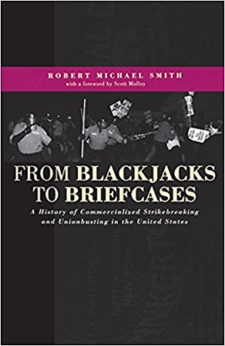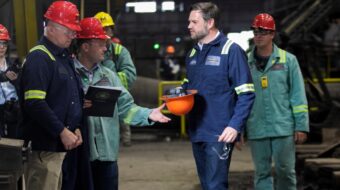 “From Blackjacks to Briefcases: A History of Commercialized Strikebreaking and Union Busting in the United States” by Robert Michael Smith, Ohio University Press, 197 pp., $16.95 (paperback)
“From Blackjacks to Briefcases: A History of Commercialized Strikebreaking and Union Busting in the United States” by Robert Michael Smith, Ohio University Press, 197 pp., $16.95 (paperback)
Strikebreaking and union-busting has taken many shapes and forms over the years, but the goals haven’t changed. While the “profession” started as an obvious, and usually violent, infringement upon workers’ rights to organize, it soon metamorphosed into something much more subtle and insidious.
As someone who has participated in organizing campaigns, I can confidently say that Robert Michael Smith’s “From Blackjacks to Briefcases: A History of Commercialized Strikebreaking and Unionbusting in the United States,” stands as a welcome contribution to the historiography of American labor/management relations.
Smith begins by chronicling the beginnings of the first professional strikebreaking agency, the Pinkerton National Detective Agency. By providing “guards” to “protect” replacement workers from striking Illinois miners in 1866, the Pinkertons’ first foray into strikebreaking proved very profitable. Even today, the Pinkertons probably remain the best known strikebreakers.
While their methods were brutal and primitive (and only partially successful) the Pinkertons quickly grew to be respected by industrialists and robber barons. Armed Pinkerton guards would escort scabs into a factory, plant or mine, all under the eye of watchmen in towers with machine guns fixed on the strikers.
After the success of the Pinkertons, hundreds of strikebreaking agencies sprung up across the nation. The Baldwin-Felts Agency “provided labor discipline services” to mine owners in West Virginia, instituting “feudal-like control over their workers … harass[ing] union organizers from the time they stepped off the train until the time they left.”
The labor movement in the United States continued to advance, however, and by the early 20th century workers had achieved minimum governmental protections. Strikebreakers now had to look for new and subtler ways of influencing the outcome of strikes. Smith tells us that beyond simply providing “guards,” professional strikebreakers now made it their business to employ an army of replacement workers, skilled in whatever trade was needed, and ready to travel to any location at any time.
James A. Farley, who became known as the “King of the Strikebreakers,” boasted to the New York City Interborough Rapid Transit Company of his roster of 35,000 transit workers. “I will send for these men wherever they happen to be, and pay their fare to the strike center. I can reach them at a minute’s notice at any time,” he told the IRT.
During the labor upsurges of the Depression era, strikebreakers and union-busters began to rely more heavily on spies and espionage. With emphasis being placed on “undercover work, which being secret, created less antagonism,” the Pinkerton National Detective Agency became the “most important supplier of industrial spies in the country.”
By providing “undercover men skilled at destroying unions from within” the Pinkertons were able to sabotage many organizing campaigns, and weaken rank and file support in many already established union locals.
Smith writes that when the Western Federation of Miners walked out of the mines, A.W. Gratias, the union relief administrator and secret Pinkerton stool, pared down relief expenditures “to cause disaffection and get the men against the union.”
Although the Pinkertons dominated much of the union-busting industry, they were not alone. One competitor bragged in an industry journal, “We are prepared to place secret operatives who are skilled mechanics in any shop, mill or factory, to discover whether any labor organizing is being done.”
Another union-busting company announced to prospective clients that it would have several delegates at the annual American Federation of Labor convention, adding, “for the sum of 15 dollars” they would provide “a full and complete report of the entire proceedings.”
While spying and collecting information on employees has continued, and in many ways intensified, union-busting and strikebreaking agencies have also refined additional, subtler techniques. By the 1960s, agencies began hosting monthly seminars designed to educate employers about their “rights” when they are faced with an organizing campaign.
Today, instead of thugs armed with rifles, modern agencies use technology to videotape, photograph and even wiretap union members and supporters.
While many of us think of union members as blue-collar employees, professional white-collar workers are also joining unions. These doctors, nurses, technicians, and many other job classifications have also had to deal with the professional union-buster and strikebreaker. A major flaw in Smith’s book is its lack of information on union-busting and strikebreaking in the white-collar workforce.
Strikebreaking continues to be a lucrative profession. “From Blackjack to Briefcases” should be read by anyone interested in economic and social justice.










